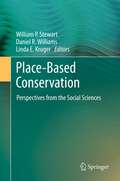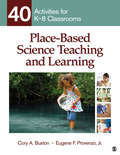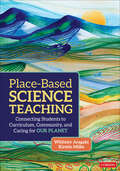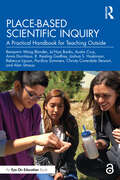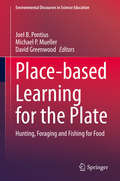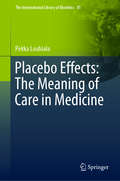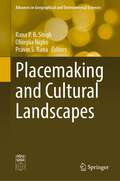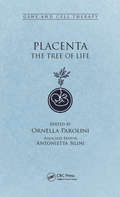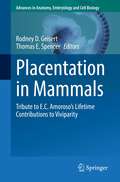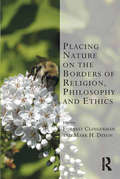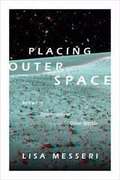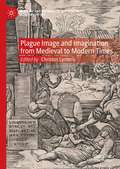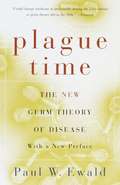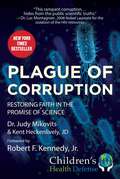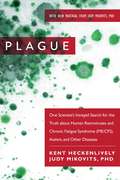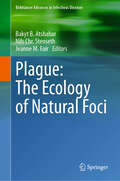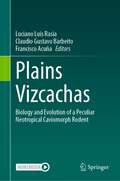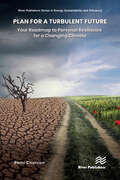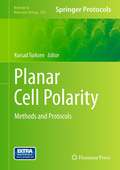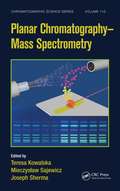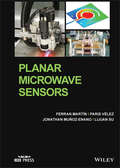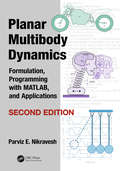- Table View
- List View
Place-Based Conservation
by Linda E. Kruger Suzette Dailey William P. StewartThe concept of "Place" has become prominent in natural resource management, as professionals increasingly recognize the importance of scale, place-specific meanings, local knowledge, and social-ecological dynamics. Place-Based Conservation: Perspectives from the Social Sciences offers a thorough examination of the topic, dividing its exploration into four broad areas. Place-Based Conservation provides a comprehensive resource for researchers and practitioners to help build the conceptual grounding necessary to understand and to effectively practice place-based conservation.
Place-Based Science Teaching and Learning: 40 Activities for K-8 Classrooms
by Dr Cory A. Buxton Dr Eugene F. ProvenzoForty classroom-ready science teaching and learning activities for elementary and middle school teachersGrounded in theory and best-practices research, this practical text provides elementary and middle school teachers with 40 place-based activities that will help them to make science learning relevant to their students. This text provides teachers with both a rationale and a set of strategies and activities for teaching science in a local context to help students engage with science learning and come to understand the importance of science in their everyday lives.
Place-Based Science Teaching: Connecting Students to Curriculum, Community, and Caring for Our Planet
by Whitney Aragaki Kirstin MilksJumpstart your imagination and transform your science classroom by centering place-based learning Identity, community, and place are tightly connected and can be leveraged to deepen science learning for students. Place-Based Science Teaching offers K-12 science educators an innovative approach to building learning experiences that embrace the rich and varied knowledge held by people, both past and present, about the places we call home. This book helps teachers to foster greater personal investment of students in their learning, as well as develop NGSS-informed authentic problem-solving and critical reasoning skills. The book will also help teachers create and find joy in their classrooms by connecting lessons to local environments, cultural heritage, and global issues. Written by nationally recognized STEM educators Whitney Aragaki and Kirstin Milks, the book blends inspiring storytelling with practical frameworks and resources. Chapters will take you behind the scenes into innovative classrooms, detailing high-impact, standards-aligned activities and sharing educator stories from diverse settings. Grounded in cutting-edge research and real-world examples, Place-Based Science Teaching Introduces the Place Based Science Teaching Framework that asks "where are you," "when are you," "who are you," and "who are we together" as a way to connect learning to local and global contexts Provides classroom-ready lessons and case studies from many educational settings, aligned with NGSS and centered on belonging, access, and engagement Offers strategies for virtual spaces and digital perspectives to enhance teaching in an increasingly online world Includes actionable reflection prompts designed to help teachers explore their own positionality and better connect with their students and communities This book will encourage educators and administrators alike to transform science learning into an opportunity for building empathy, connection, and hope. Place-Based Science Teaching is designed to help teachers foster a sense of place and stewardship among their students, and address peace- and justice-focused solutions that encourage students to care for their communities, think critically about global challenges, and develop the agency to lead for generations to come.
Place-Based Science Teaching: Connecting Students to Curriculum, Community, and Caring for Our Planet
by Whitney Aragaki Kirstin MilksJumpstart your imagination and transform your science classroom by centering place-based learning Identity, community, and place are tightly connected and can be leveraged to deepen science learning for students. Place-Based Science Teaching offers K-12 science educators an innovative approach to building learning experiences that embrace the rich and varied knowledge held by people, both past and present, about the places we call home. This book helps teachers to foster greater personal investment of students in their learning, as well as develop NGSS-informed authentic problem-solving and critical reasoning skills. The book will also help teachers create and find joy in their classrooms by connecting lessons to local environments, cultural heritage, and global issues. Written by nationally recognized STEM educators Whitney Aragaki and Kirstin Milks, the book blends inspiring storytelling with practical frameworks and resources. Chapters will take you behind the scenes into innovative classrooms, detailing high-impact, standards-aligned activities and sharing educator stories from diverse settings. Grounded in cutting-edge research and real-world examples, Place-Based Science Teaching Introduces the Place Based Science Teaching Framework that asks "where are you," "when are you," "who are you," and "who are we together" as a way to connect learning to local and global contexts Provides classroom-ready lessons and case studies from many educational settings, aligned with NGSS and centered on belonging, access, and engagement Offers strategies for virtual spaces and digital perspectives to enhance teaching in an increasingly online world Includes actionable reflection prompts designed to help teachers explore their own positionality and better connect with their students and communities This book will encourage educators and administrators alike to transform science learning into an opportunity for building empathy, connection, and hope. Place-Based Science Teaching is designed to help teachers foster a sense of place and stewardship among their students, and address peace- and justice-focused solutions that encourage students to care for their communities, think critically about global challenges, and develop the agency to lead for generations to come.
Place-Based Scientific Inquiry: A Practical Handbook for Teaching Outside
by Benjamin Wong Blonder Ja'Nya Banks Austin Cruz Anna Dornhaus R. Keating Godfrey Joshua S. Hoskinson Rebecca Lipson Pacifica Sommers Christy Stewart Alan StraussLearn how to facilitate scientific inquiry projects by getting out of the classroom and connecting to the natural environment—in your schoolyard, or in your community! Providing a contemporary perspective on how to do scientific inquiry in ways that can make teachers’ lives easier and students’ experiences better, this book draws on authentic inquiry, engaging with communities, and teaching through project-based learning to help students design and carry out scientific inquiry projects that are grounded in their local places. This accessible guide will help you to develop skills around facilitation, team building, and learning outdoors in schoolyards and parks, acting as a go-to toolkit for teachers to help build confidence and skills in these areas. Written according to the Next Generation Science Standards, this book supports teachers in fostering community engagement and a justice-first classroom. The approachable resources included in this book will help teachers with all levels of experience succeed in empowering students grades 3–12 in their science learning. Additional support materials including template documents for student use and for teacher planning, as well as examples of real student work, are available online. The Open Access version of this book, available at www.taylorfrancis.com, has been made available under a Creative Commons Attribution (CC-BY) 4.0 license
Place-based Learning for the Plate: Hunting, Foraging and Fishing for Food (Environmental Discourses in Science Education #6)
by Michael P. Mueller David Greenwood Joel B. PontiusThis edited volume explores 21st century stories of hunting, foraging, and fishing for food as unique forms of place-based learning. Through the authors’ narratives, it reveals complex social and ecological relationships while readers sample the flavors of foraging in Portland, Oregon; feel some of what it’s like to grow up hunting and gathering as a person of Oglala Lakota and Shoshone-Bannock descent; track the immersive process of learning to communicate with rocky mountain elk; encounter a road-killed deer as a spontaneous source of local meat, and more.Other topics in the collection connect place, food, and learning to issues of identity, activism, spirituality, food movements, conservation, traditional and elder knowledge, and the ethics related to eating the more-than-human world. This volume will bring lively discussion to courses on place-based learning, food studies, environmental education, outdoor recreation, experiential education, holistic learning, human dimensions of natural resource management, sustainability, food systems, environmental ethics, and others.
Placebo Effects: The Meaning of Care in Medicine (The International Library of Bioethics #81)
by Pekka LouhialaThis book provides a perspective on the concepts placebo and placebo effects, which has been missing so far: a detailed analysis of the history of the terms, their current use, suggested alternatives and the implications of the conceptual confusion. Everybody knows something about placebos and placebo effects. If, however, people are asked to define the concepts, the spectrum becomes wide. Does 'placebo' refer to an inert treatment or does it cover all elements of the patient-physician-interaction except for pharmacological or other physiological mechanisms? Furthermore, if, by definition, a placebo has no effect, what sense does it make to talk about a 'placebo effect'? Even in scientific literature the concepts ‘placebo’ and ‘placebo effect’ are used in many senses and often in a confusing way. While this book discusses many issues which keep puzzling physicians, it also covers the historical developments of the concepts of placebo and placebo effect as well as the conceptual confusion in the definitions. This book is intended for physicians, philosophers, psychologists and any other people interested in placebos, placebo effects and the physician-patient relationship.
Placemaking and Cultural Landscapes (Advances in Geographical and Environmental Sciences)
by Pravin S. Rana Olimpia Niglio Rana P. B. SinghPlacemaking and cultural landscapes are worldwide multidisciplinary global concerns that cover many points of view of the common impacts of socio-economic cultural and rights jurisprudence planning, wellbeing and related advancements. Concerned with the complex interactions between the development and environment of those factors, it is important to seek ways, paths and implications for framing sustainability in all social activities. This book is mostly based on the 10th ACLA – Asian Cultural Landscape Association International Webinar Symposium that took place during September 26–27, 2020, in the Banaras Hindu University, Varanasi, India. It examines contemporary social–cultural issues in the context of the United Nations Sustainable Development Goals (UN-SDGs) and associated cultural and sacred landscapes. There, the emphasis is on awakening deeper cultural sensitivity in harmonizing the world and the role of society and spiritual systems, drawing upon multi-disciplinary and cross-cultural interfaces—all within the scope of the future of the earth. The book’s chapters add a new dimension of cultural understanding in the broad domain of emerging human geoscience, considered as key policy science for contributing towards sustainability and survivability science together with future earth initiatives.
Placenta: The Tree of Life (Gene And Cell Therapy Ser. #2)
by Ornella ParoliniLong regarded as biological waste, the placenta is gaining momentum as a viable product for clinical use. Due to their unique properties, placental cells and derivatives show great promise in curing various diseases. Utilizing contributions from world-renowned experts, Placenta: The Tree of Life considers the therapeutic potential of these cells. I
Placentation in Mammals: Tribute to E.C. Amoroso’s Lifetime Contributions to Viviparity (Advances in Anatomy, Embryology and Cell Biology #234)
by Rodney D. Geisert Thomas E. SpencerThe present volume of the book series Advances in Anatomy, Embryology and Cell Biology brings together current reviews from leading experts to address the diversity of placentation by which species establish and maintain pregnancy. Development of viviparity and placentation in rodents, dogs, pigs, cattle, horses, marsupials, primates and elephants are discussed. The development of viviparity in mammals, including some invertebrate species, required the adaptation of the placenta to serve as a functional conduit for interplay between the semiallograftic fetus with the maternal uterus. Although the ‘placenta’ protects the fetus from maternal immune rejection and provides oxygen and nutrient flow to support it to term across all the species, structural differentiation of this fetal-maternal interface can vary from simple to very complex. E.C. Amoroso contributed greatly to our early understanding and knowledge of placentation across a great variety of species. His work on placentation provides numerous illustrations and histological sections which are used for teaching and stimulating research today. With this book, we want to pay tribute to his lifetime contributions to the field by reviewing our current understanding of the development of viviparity and placentation in different species. The book is written for researchers, physicians and medical students working in the field of reproductive science or with an interest in placentation and viviparity.
Placing Nature on the Borders of Religion, Philosophy and Ethics (Transcending Boundaries in Philosophy and Theology)
by Forrest Clingerman Mark H. DixonThe natural world has been "humanized": even areas thought to be wilderness bear the marks of human impact. But this human impact is not simply physical. At the emergence of the environmental movement, the focus was on human effects on "nature." More recently, however, the complexity of the term "nature" has led to fruitful debates and the recognition of how human individuals and cultures interpret their environments. This book furthers the dialogue on religion, ethics, and the environment by exploring three interrelated concepts: to recreate, to replace, and to restore. Through interdisciplinary dialogue the authors illuminate certain unique dimensions at the crossroads between finding value, creating value, and reflecting on one's place in the world. Each of these terms has diverse religious, ethical, and scientific connotations. Each converges on the ways in which humans both think about and act upon their surroundings. And each radically questions the damaging conceptual divisions between nature and culture, human and environment, and scientific explanation and religious/ethical understanding. This book self-consciously reflects on the intersections of environmental philosophy, environmental theology, and religion and ecology, stressing the importance of how place interprets us and how we interpret place. In addition to its contribution to environmental philosophy, this work is a unique volume in its serious engagement with theology and religious studies on the issues of ecological restoration and the meaning of place.
Placing Outer Space: An Earthly Ethnography of Other Worlds
by Lisa MesseriIn Placing Outer Space Lisa Messeri traces how the place-making practices of planetary scientists transform the void of space into a cosmos filled with worlds that can be known and explored. Making planets into places is central to the daily practices and professional identities of the astronomers, geologists, and computer scientists Messeri studies. She takes readers to the Mars Desert Research Station and a NASA research center to discuss ways scientists experience and map Mars. At a Chilean observatory and in MIT's labs she describes how they discover exoplanets and envision what it would be like to inhabit them. Today's planetary science reveals the universe as densely inhabited by evocative worlds, which in turn tells us more about Earth, ourselves, and our place in the universe.
Plague Image and Imagination from Medieval to Modern Times (Medicine and Biomedical Sciences in Modern History)
by Christos LynterisThis edited collection brings together new research by world-leading historians and anthropologists to examine the interaction between images of plague in different temporal and spatial contexts, and the imagination of the disease from the Middle Ages to today. The chapters in this book illuminate to what extent the image of plague has not simply reflected, but also impacted the way in which the disease is experienced in different historical periods. The book asks what is the contribution of the entanglement between epidemic image and imagination to the persistence of plague as a category of human suffering across so many centuries, in spite of profound shifts in our medical understanding of the disease. What is it that makes plague such a visually charismatic subject? And why is the medical, religious and lay imagination of plague so consistently determined by the visual register? In answering these questions, this volume takes the study of plague images beyond its usual, art-historical framework, so as to examine them and their relation to the imagination of plague from medical, historical, visual anthropological, and postcolonial perspectives.
Plague Time: The New Germ Theory of Disease, First Edition
by Paul W. EwaldAccording to conventional wisdom, our genes and lifestyles are the most important causes of the most deadly ailments of our time. Conventional wisdom may be wrong. In this controversial book, the eminent biologist Paul W. Ewald offers some startling arguments: <P><P><ul> <li>Germs appear to be at the root of heart disease, Alzheimer’s, schizophrenia, many forms of cancer, and other chronic diseases.</li> <li>The greatest threats to our health come not from sensational killers such as Ebola, West Nile virus, and super-virulent strains of influenza, but from agents that are already here causing long-term infections, which eventually lead to debilitation and death.</li> <li>The medical establishment has largely ignored the evidence that implicates these germs, to the detriment of our public health.</li> <li>New evolutionary theories are available, which explain how germs function and offer opportunities for controlling these modern plagues — if we are willing to listen to them.</li> </ul> <P><P>Plague Time is an eye-opening exploration of the revolutionary new understanding of disease that may set the course of medical research for the twenty-first century.
Plague of Corruption: Restoring Faith in the Promise of Science (Children’s Health Defense)
by Judy Mikovits Kent Heckenlively<P><P> Dr. Judy Mikovits is a modern-day Rosalind Franklin, a brilliant researcher shaking up the old boys’ club of science with her groundbreaking discoveries. And like many women who have trespassed into the world of men, she uncovered decades-old secrets that many would prefer to stay buried. From her doctoral thesis, which changed the treatment of HIV-AIDS, saving the lives of millions, including basketball great Magic Johnson, to her spectacular discovery of a new family of human retroviruses, and her latest research which points to a new golden age of health, <P><P>Dr. Mikovits has always been on the leading edge of science. With the brilliant wit one might expect if Erin Brockovich had a doctorate in molecular biology, Dr. Mikovits has seen the best and worst of science. When she was part of the research community that turned HIV-AIDS from a fatal disease into a manageable one, she saw science at its best. <P><P>But when her investigations questioned whether the use of animal tissue in medical research were unleashing devastating plagues of chronic diseases, such as autism and chronic fatigue syndrome, she saw science at its worst. If her suspicions are correct, we are looking at a complete realignment of scientific practices, including how we study and treat human disease. <P><P>Recounting her nearly four decades in science, including her collaboration of more than thirty-five years with Dr. Frank Ruscetti, one of the founders of the field of human retrovirology, this is a behind the scenes look at the issues and egos which will determine the future health of humanity. <p><p><b>A New York Times Bestseller</b>
Plague, Fear, and Politics in San Francisco's Chinatown
by Guenter B. RisseWhen health officials in San Francisco discovered bubonic plague in their city’s Chinatown in 1900, they responded with intrusive, controlling, and arbitrary measures that touched off a sociocultural conflict still relevant today. Guenter B. Risse’s history of an epidemic is the first to incorporate the voices of those living in Chinatown at the time, including the desperately ill Wong Chut King, believed to be the first person infected.Lasting until 1904, the plague in San Francisco's Chinatown reignited racial prejudices, renewed efforts to remove the Chinese from their district, and created new tensions among local, state, and federal public health officials quarreling over the presence of the deadly disease. Risse's rich, nuanced narrative of the event draws from a variety of sources, including Chinese-language reports and accounts. He addresses the ecology of Chinatown, the approaches taken by Chinese and Western medical practitioners, and the effects of quarantine plans on Chinatown and its residents. Risse explains how plague threatened California’s agricultural economy and San Francisco’s leading commercial role with Asia, discusses why it brought on a wave of fear mongering that drove perceptions and intervention efforts, and describes how Chinese residents organized and successfully opposed government quarantines and evacuation plans in federal court. By probing public health interventions in the setting of one of the most visible ethnic communities in United States history, Plague, Fear, and Politics in San Francisco’s Chinatown offers insight into the clash of Eastern and Western cultures in a time of medical emergency.
Plague: One Scientist's Intrepid Search for the Truth about Human Retroviruses and Chronic Fatigue Syndrome (ME/CFS), Autism, and Other Diseases (Children's Health Defense Ser.)
by Judy Mikovits Kent HeckenlivelyOn July 22, 2009, a special meeting was held with twenty-four leading scientists at the National Institutes of Health to discuss early findings that a newly discovered retrovirus was linked to chronic fatigue syndrome (CFS), prostate cancer, lymphoma, and eventually neurodevelopmental disorders in children. When Dr. Judy Mikovits finished her presentation the room was silent for a moment, then one of the scientists said, "Oh my God!" The resulting investigation would be like no other in science.For Dr. Mikovits, a twenty-year veteran of the National Cancer Institute, this was the midpoint of a five-year journey that would start with the founding of the Whittemore-Peterson Institute for Neuro-Immune Disease at the University of Nevada, Reno, and end with her as a witness for the federal government against her former employer, Harvey Whittemore, for illegal campaign contributions to Senate Majority Leader Harry Reid.On this journey Dr. Mikovits would face the scientific prejudices against CFS, wander into the minefield that is autism, and through it all struggle to maintain her faith in God and the profession to which she had dedicated her life. This is a story for anybody interested in the peril and promise of science at the very highest levels in our country.
Plague: The Ecology of Natural Foci (Birkhäuser Advances in Infectious Diseases)
by Nils Chr. Stenseth Jeanne M. Fair Bakyt B. AtshabarThis book provides deep insights into the ecology of the plague bacterium Yersinia pestis in natural foci, its diversity, genetic variability and the function of the vector, thus painting a holistic picture of how plague pandemics have evolved and how the bacterium has adapted perfectly to its environment over such a long period of time. The book reviews studies of several generations of scientists from the countries of the former Soviet Union where plague foci are found and presents them for the first time to a global audience. In addition, the book provides comprehensive information on historical plague pandemics and explores future strategies for managing the disease.
Plagues (The Darwin College Lectures)
by Sven Friedemann Jonathan L. HeeneyPlagues have inflicted misery and suffering throughout history. They can be traced through generations in our genes, with echoes in religion and literature. Featuring essays arising from the 2014 Darwin College Lectures, this book examines the spectrum of tragic consequences of different types of plagues, from infectious diseases to over-population and computer viruses. The essays analyse the impact that plagues have had on humanity and animals, and their threat to the very survival of the world as we know it. On the theme of plagues, each essay takes a unique perspective, ranging from the impact of plagues on history, medicine, the evolution of species, and biblical metaphors, to their impact on national economies, and even our highly connected digital lifestyles. This engaging and timely collection challenges our understanding of plagues, and asks if plagues are the manifestation of nature's checks and balances in light of human population growth and our impact on climate change. A stimulating collection of essays written by a distinguished group of scholars with a diverse approach to their theme. Provides a multidisciplinary examination of the effects of plagues, from early history to current medicine and the future. Analyses different types of plagues, from infectious diseases to over-population and computer viruses.
Plains Vizcachas: Biology and Evolution of a Peculiar Neotropical Caviomorph Rodent
by Luciano Luis Rasia Claudio Gustavo Barbeito Francisco AcuñaThe plains vizcacha (Lagostomus maximus) is a remarkable rodent of the Neotropic given several peculiar aspects of its biology, some of them quite unique among rodents or even among mammals. This book gathers specialists studying plains vizcachas from very different approaches, including paleontology, systematics, morphology, physiology, development and conservation. It is divided in two Parts, 1) Evolutionary History, and 2) Morphology, Development and Physiology. It will surely be a required reading for any researcher working with caviomorph rodents, mastozoology of the Neotropics or internal anatomy and physiology of mammals.
Plan for a Turbulent Future: Your Roadmap to Personal Resilience for a Changing Climate
by Remi CharronMillions of lives and businesses have either been lost or significantly impacted by COVID-19. Yet, many are warning that climate change will be much more devastating over the coming decades. Reality is starting to set in. We are not going to achieve our global mitigation targets; we probably won’t even come close. Individuals faced with this reality react differently, from willful ignorance to anxiety and depression, all normal reactions. If you believe in science and understand the likelihood of our failure to meet our targets, you need to accept and plan for an unknown, challenging future. We may be individually powerless to stop climate change, but we certainly can act in ways that will help us better face the consequences. This book provides a structured approach to plan and prepare today for a world rocked by a turbulent climate.
Planar Cell Polarity
by Kursad TurksenPlanar cell polarity (PCP), or the alignment of a collection of cells within a cell sheet, has proven, over time, to be vital in not only normal development but also in disease states. In Planar Cell Polarity: Methods and Protocols, expert researchers in the field present a number of detailed and well-designed protocols used successfully in their labs around the world. As a volume in the highly successful Methods in Molecular BiologyTM series, the chapters contain introductions to their respective topics, lists of the necessary materials and reagents, step-by-step, readily reproducible laboratory protocols, and tips on troubleshooting and avoiding known pitfalls. Timely and authoritative, Planar Cell Polarity: Methods and Protocols serves as a valuable reference for both novices and experts in this dynamic and versatile area of study.
Planar Chromatography - Mass Spectrometry (Chromatographic Science Series)
by Teresa Kowalska Mleczyslaw Sajewlcz Joseph SharmaPlanar Chromatography-Mass Spectrometry focuses on a relatively new approach to chemical analysis in general, and to separation science in particular. It is the first book to systemically cover the theoretical background, techniques, instrumentation, and practical applications of planar chromatography-mass spectrometry as a hyphenated tool of analy
Planar Microwave Sensors (IEEE Press)
by Ferran Martín Paris Vélez Jonathan Muñoz-Enano Lijuan SuComprehensive resource detailing the latest advances in microwave and wireless sensors implemented in planar technology Planar Microwave Sensors is an authoritative resource on the subject, discussing the main relevant sensing strategies, working principles, and applications on the basis of the authors’ own experience and background, while also highlighting the most relevant contributions to the topic reported by international research groups. The authors provide an overview of planar microwave sensors grouped by chapters according to their working principle. In each chapter, the working principle is explained in detail and the specific sensor design strategies are discussed, including validation examples at both simulation and experimental level. The most suited applications in each case are also reported. The necessary theory and analysis for sensor design are further provided, with special emphasis on performance improvement (i.e., sensitivity and resolution optimization, dynamic range, etc.). Lastly, the work covers a number of applications, from material characterization to biosensing, including motion control sensors, microfluidic sensors, industrial sensors, and more. Sample topics covered in the work include: Non-resonant and resonant sensors, reflective-mode and transmission-mode sensors, single-ended and differential sensors, and contact and contactless sensors Design guidelines for sensor performance optimization and analytical methods to retrieve the variables of interest from the measured sensor responses Radiofrequency identification (RFID) sensor types, prospective applications, and materials/technologies towards “green sensors” implementation Comparisons between different technologies for sensing and the advantages and limitations of microwave sensors, particularly planar sensors Engineers and qualified professionals involved in sensor technologies, along with undergraduate and graduate students in related programs of study, can harness the valuable information inside Planar Microwave Sensors to gain complete foundational knowledge on the subject and stay up to date on the latest research and developments in the field.
Planar Multibody Dynamics: Formulation, Programming with MATLAB®, and Applications, Second Edition
by Parviz E. NikraveshPlanar Multibody Dynamics: Formulation, Programming with MATLAB®, and Applications, Second Edition, provides sets of methodologies for analyzing the dynamics of mechanical systems, such as mechanisms and machineries, with coverage of both classical and modern principles. Using clear and concise language, the text introduces fundamental theories, computational methods, and program development for analyzing simple to complex systems. MATLAB is used throughout, with examples beginning with basic commands before introducing students to more advanced programming techniques. The simple programs developed in each chapter come together to form complete programs for different types of analysis.
